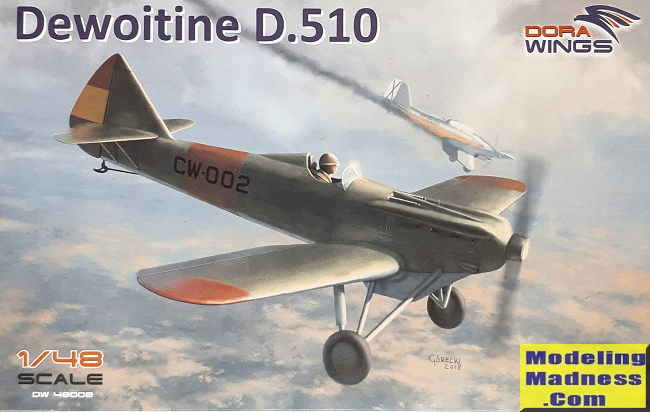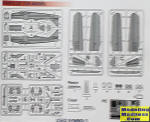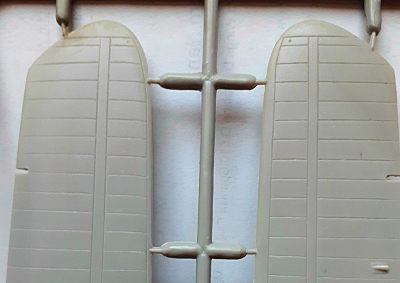
Dora Wings 1/48 Dewoitine D.510
| KIT #: | 48008 |
| PRICE: | $3t.00 |
| DECALS: | Four options |
| REVIEWER: | John Summerford |
| NOTES: | Lacking color information |

| HISTORY |
Perhaps the most significant derivative of the D.500 was the D.510 first flown in 1932. The main difference being the adoption of a more powerful Hispano-Suiza 12-cylinder engine, capable of 640 kW (860 hp). Minor refinements included a slightly lengthened nose, an increase in fuel capacity, and a refined undercarriage arrangement.
The Dewoitine D.500 was an all-metal low-wing cantilever monoplane. It featured a streamlined nose section that housed the aircraft's powerplant. Underneath the fuselage was a large-volume radiator, which was designed to present the smallest possible frontal area while meeting the cooling requirements of the engine. The cockpit of the D.500 was located directly above the trailing edge of the wing. The pilot was provided with a vertically-adjustable seat, which could be raised in-flight to improve visibility for landing. The cockpit was furnished with an oxygen system and radio. The control stick was connected to the aircraft's ailerons via a rod transmission to horns present on the upper wing's surface.
The D.500 was furnished with low-mounted elliptical, all-metal cantilever wing, possessing an aspect ratio of 8.9. It possessed a relatively small chord and contained only a single spar, akin to the record-setting Dewoitine D.33. The wing's strength came from its box spar, which was formed from a pair of vertical webs of sheet metal that connect with the flanges, which are in turn riveted to the flat sheet rib arcs of the sheet covering. [Much like the fuselage of the Me 108 and Me 109.] The wing had a thickness of 0.3 m (11,81 in.) at the root, gradually tapering towards its rounded-off tips. Balanced ailerons extended throughout the span, except near the fuselage, where these were reduced to provide greater downward visibility for the pilot. The lower wing surface sat only 1.5 m (4.92 ft.) above the ground, which generated a beneficial ground effect to significantly reduce landing speeds.
| THE KIT |
 Five
gray plastic sprues are held in a single bag with the decals plus photo-etch
parts, clear sprue, acetate instruments, and resin parts separately bagged
within the main bag. Flash is present on some of the smaller par
Five
gray plastic sprues are held in a single bag with the decals plus photo-etch
parts, clear sprue, acetate instruments, and resin parts separately bagged
within the main bag. Flash is present on some of the smaller par ts,
but itís easy to clean up. Detail is appropriate for this scale. Of note, are
the panel lines for each wing rib. Some of the photo-etch seems a bit ďfiddlyĒ.
ts,
but itís easy to clean up. Detail is appropriate for this scale. Of note, are
the panel lines for each wing rib. Some of the photo-etch seems a bit ďfiddlyĒ.
Two building options are provided, either a Spanish civil war veteran or a Japanese demonstrator. However, it takes some sleuthing to figure out which parts are relevant to each option. My understanding is that the Japanese aircraft did not have nose mounted guns, so the plastic upper cowl part is needed. A Spanish civil war plane needs the resin cowl piece and resin gun barrels. The Japanese plane also had a two-bladed prop (versus a three-bladed unit) and shortened main gear struts. These parts are found on sub-sprue E-1. Total parts count is, including photo-etch and acetate, is 100.
 Assembly
instructions are on one single-fold sheet of black and white line drawings and
are broken down into 16 steps. A separate glossy sheet has paint and decal
markings. The colors are not identified, so some research is required.
Assembly
instructions are on one single-fold sheet of black and white line drawings and
are broken down into 16 steps. A separate glossy sheet has paint and decal
markings. The colors are not identified, so some research is required.
| CONCLUSIONS |
Iím a fan of Dora Wings. This is a good kit to use if one wishes to develop oneís skill building short-run kits. Iím sure Iíll enjoy this build but I am annoyed by the lack of color call-outs.
I was unable to find a cockpit image of the internet, but I suspect that the interior was either unpainted or coated silver. Other modelers have used the interior colors of the later 520, but Iím not convinced that is correct
Tamiya has produced a kit in 1/48th scale of the follow-on design 520, so a nice pairing can be done, or perhaps beside a P-26.
John
Summerford
December 2020 Copyright ModelingMadness.com. All rights reserved If you would like your product reviewed fairly and fairly quickly, please contact the editor
or see other details in the
Note to
Contributors. Back to the Main Page
Back to the Review
Index Page
Back to the Previews Index Page